Oxygen Not Included Shine Bug Feeding
Shine Bug in the game are represented by 7 species. They all have the same properties except for the decor. The decor value varies from +30 within 5 cells for a Shine Bug, to +200 within 8 cells for a Radiant Bug.
Depending on the food, the chance of a particular kind of Shine Bug increases. Of all the diet of Shine Bug, the easiest, imho, to get phosphorite, for example with the farm Dreсko.
We will, however, be interested in its ability to emit light and a 4 panel solar power plant will be built on this farm. Shine Bug do not give resources, and no meat falls out of them when they die. However, when they hatch, they are left with a shell, which is also useful.
Their reproduction rate is huge, so it makes no sense to use incubators.
Characteristics of Shine Bug [ ]
- Diet: 0.17 kg/cycle (Shine Bug) - Bristle Berry, Gristle Berry, Phosphorite, Fried Mushroom, Pepper Bread, Pincha Peppernut, Stuffed Berry, Abyssalite, Barbeque, Meat, Diamond.
- Produces: 1800 lux light in a 5 cell radius
- Life span: 25 cycles
- Breeding rate: 7% (no care), 67% (with care)
- Incubation rate: 25% (basic)
- Room size: 12 cages/сritter
- Temperature: -10.1...+39.9°C
Description [ ]



The scheme consists of a 96-cell stable. The enclosure is limited to a room with a grooming station and a room with solar panels (the base of the panels is considered a tile).
Shine Bug are restricted in their movements in 1 cell, instead of flying chaotically over the panels. This ensures an even distribution of Shine Bug and saves the computer resources (it does not have to calculate paths of movement for Shine Bug).
All troughs on the left side are limited by water, so that the Shine Bug can not fly apart. Since each panel requires at least 55 Shine Bug to light up, the total number will reach over 220, and the total size of your base void space should be at least 2640 cells.
It is better to provide much bigger size, because not only Shine Bug, but also wild animals and animals of your other open farms will be counted.
Automatics [ ]


All eggs are collected by the Auto-Sweeper and passed through the conveyor controller, either returned to the stable (if there are less than 8) or sent to the solar panels.
Conveyors and loaders located on top are used to collect the shells. They are activated by a timer (in the cycles mode) 1 time in 5 cycles, for a short time so as not to waste energy on collecting every 100 grams of shells, but to collect them at once in big portions. The upper loaders are shells, the loader in the stable is eggs. The shells at the chute in the stable are removed manually by the dupes (you only have to do it at start time).
Critter sensor <8.
Once the circuit is in working mode (about 55 Shine Bug + eggs above each panel), feeding and maintenance of Shine Bug can be stopped. The Shine Bug will have time to lay 1 egg before it dies, i.e. the farm becomes self-reproducing without any cost or participation of dupes. However, you may continue to increase your population further if you want to get a lot of eggshells.
Conclusions [ ]



The circuit provides about 1520 W of energy and 0.9 kg of shell per cycle, consuming just over 1 kg of phosphorus per cycle (during the start-up phase).
The floor in the stable is also made of glass to pass the decor down (it is inefficient to place a panel there - it will give just over 30 watts). Another controller and outgoing conveyor can be added to the circuit to periodically direct some of the eggs, for example to the Bristle Blossom farm or anywhere else in the base, saving energy on lighting and raising the decor.
The scheme can be expanded by a huge number of panels (second option), or shortened to the number you need.
Improved version [ ]
On the Klei forum, user LadenSwallow, suggested the idea of restricting Shine Bug with a water lock. This way the shine bug will be in the very center of the panel and they will need less. With this principle in mind this scheme is built:


Everything is the same as the scheme above, but shine bug are limited to a two-layer water trap. You can choose any liquid for it. Unlike sunlight, the light from Shine Bug is not attenuated by liquids.
There should be about 35 grams of liquid in each cell. This small amount can be poured by passing a pipe in the right place, limiting the flow with a valve, and breaking sections of the pipe in the right place.
As a result, to run the panel at full power, only 32 shine bug above each, as opposed to 55 in the first version. This will reduce the time the circuit takes to reach operating mode and should reduce the load on the computer.
For a 1.5 kW circuit, this is not a necessary complication (it's easier to wait a bit than to bother with pipes), but for a 7 kW circuit, it should be a very useful improvement.
7kW Option [ ]
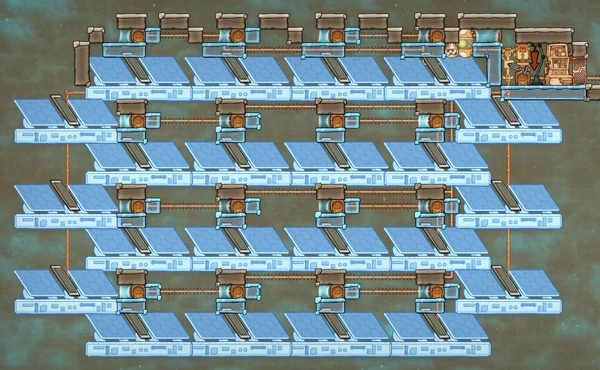
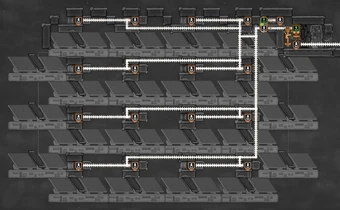
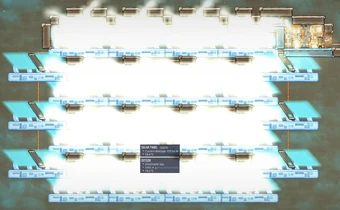
Same as the first version, but the panels are set to a total power of 8.36 kW, and there are no shell cleaning conveyors for simplicity. Since the side panels will receive half as much light, the maximum power of the circuit is about 7 kW.
The main problem with the scheme is the long time it takes to reach full power. The previous scheme, it takes about 45...50 cycles to give birth to 220 Shine Bug (8 Shine Bug give birth to 5.36 new ones every cycle, plus time to replenish the main population). This same scheme would take 4 times as many. Also, halfway through, my computer started to slow down a bit.
Therefore, I can recommend this scheme to the owners of powerful computers and nerves of steel:)
Automatics is the same. The electrics are shown conventionally.
5.8kW Option [ ]
The collective mind, represented by LadenSwallow and Tranoze, gave birth to another variant of the panel arrangement, but on the basis of which this scheme was built:
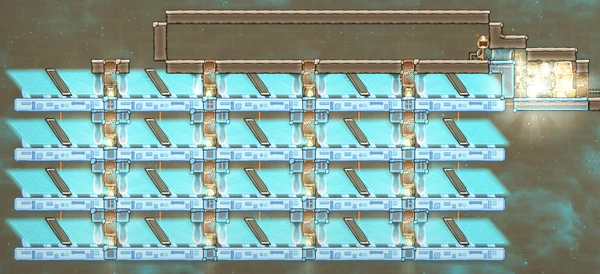
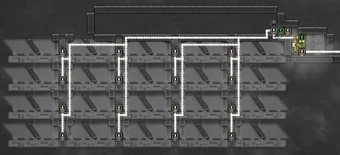
The same as in the improved version for 1.5 kW, but the Shine bug need less - 28 pcs per one chute.
The scheme developed a power of 5.8 kW, which is less than the scheme for 7 kW, but at the same time the Shine bug need two times less, only 448 pieces. This number is already under the power of not the oldest computers.
A full discussion of the circuit can be read on the Klei forum. There's also a monster 6.9 kW version for 462 eggs.
Blueprint [ ]
Shine Bug Shine Bug mk2 Shine Bug 7kW Shine Bug 5,8кВт
Source: https://oxygen-not-included-guide.fandom.com/wiki/Shine_Bug_Farm
0 Response to "Oxygen Not Included Shine Bug Feeding"
Post a Comment